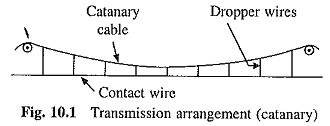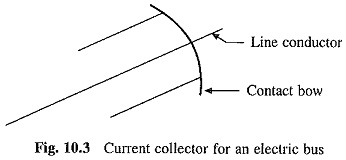Electric Traction Services:
Electric Traction Services can be broadly classified as:
- Electric Trains.
- Electric buses, trams (or tramways) and trolleys.
- Battery driven and solar powered vehicles.
Electric Trains:
Electric trains run on fixed rails. They are further classified as Main Line Trains and Suburban Trains.
Main Line Trains:
Intercity passenger and goods trains which come under this category have trailer coaches carrying men and material driven by locomotives carrying driving motors. Since driving motors travel with locomotive, power supply to the motors is arranged in two ways: from overhead transmission line in electrical locomotive and from diesel generator set mounted on the locomotive in a Diesel Electric Locomotive.
In electric locomotive, driving motor and power modulators are housed in the locomotive. An overhead transmission line is laid along or above the track (or rails). A current collector mounted over the locomotive has a conductor strip which slides against the supply conductor and thus maintains continuous contact between the supply and the locomotive. The supply conductor is commonly known as contact wire. In order to ensure good contact between the current collector and contact wire, the latter is maintained horizontal by supporting it by “catanary cable” and “dropper” wires, which in turn are supported at interval by appropriate structures (Fig. 10.1). For high speed trains, contact wires are rarely given a vertical inclination to the track greater than 1 in 300. At the same time the lateral position of the wire above the rails is staggered from side to side between supports to even the wear on the collector, caused as it slides along the contact wire. The commonly used collector has the shape of a pentagon, therefore, it is called a Pantograph Collector (Fig. 10.2). It has a conducting strip which is pressed against the contact wire by springs. The collector strips are usually of steel with grease lubrication, or of carbon, in which case no lubrication is needed. Function of the pantograph is to maintain as constant a pressure as possible between the collector strip and contact wire and to prevent any vertical oscillation of the collector strip; as these will produce arcing due to breaking of electric contact. When the pantograph is not in use, it is maintained in lower position with the help of stiff springs. When to be used, the collector strip is raised by compressed air. For high speed trains, the design of collector is critical.
As supply lines are to be laid all along the track, with adequate spacing, the economy dictates use of minimum number of such lines. Therefore, single, phase supply is used. The current enters locomotive through the collector, flows through the primary of a step down transformer and returns to supply earth through locomotive wheels and one of the rails on which locomotive travels, thus avoiding need for a second conductor. Main secondary winding (or windings) of the transformer feeds the power modulator, which in turn powers the driving motors. The auxiliary secondary windings of the transformer feed power for other needs of the train such as lighting, fans, air conditioning etc.
The locomotive power ratings can be as high as 6000 HP and more. Powering such a large single phase load can lead to large unbalance in the supply system which is always three phase. In order to reduce unbalance, the track supply is divided into sections which are electrically isolated from each other, and substations supplying these sections are connected to different phases of the three phase supply. Though the unbalance is reduced, its magnitude still remains large. If the three phase supply system capacity is much larger than the power drawn by the locomotive, then this unbalance will not significantly affect the three phase supply system. Therefore, it is essential that the main source of traction supply should be sufficiently large.
When locomotive travels through different sections, the supply is momentarily disconnected when it moves from one section to another. The movement during the transition occurs because of the inertia. Momentary disruption of power produces inductive voltage spikes.
Electric Traction Services is classified as single phase ac and dc depending on the supply. It has nothing to do with the motor type. Based on the study done by French and German Railways in late forties, 25 kV was considered suitable for ac traction. Indian Railways have also adopted 25 kV, 50 Hz, single phase supply for ac traction. 25 kV, 50 Hz ac supply is now being used for main line traction throughout India, except Bombay-Igatpuri section where 1500 V dc traction is in use.
In Diesel Electric Locomotive, the electric power is generated within the locomotive by a diesel engine driven electric generator. Capital cost of Electric Traction employing electric locomotive is very high because of the necessity of having expensive transmission lines, although the total cost (capital plus running) is lower compared to Diesel Electric Traction using diesel electric locomotive.
Suburban Trains:
They are employed for transporting men within a city or between cities located at small distances. The main difference being that the distance between consecutive stops (or stations) is much smaller for suburban trains than the main line. The suburban trains are also known as local trains. Because of shortage of land in cities, they are often run through underground tunnels and are called subway trains, metros or simply underground trains. Suburban trains are driven by motor (or motorized) coaches, instead of locomotives. Each motor coach is equipped with an electric drive with its controls in driver’s cabin and a pantograph collector. Usual pattern is to use motor coaches and trailer coaches in the ratio 1 : 2. In high speed trains the ratio may be increased to 1 : 1. The trains employing motor coaches and trailer coaches are also known as Electrical Multiple Unit (EMU) trains. Such an arrangement provides the flexibility in train size. During light traffic periods, one or two units, each consisting of one motor coach and two trailer coaches form a train. During rush hours, number of such units are coupled together. Each unit is provided with local and remote control equipment, so that all the motor coaches of a train can be controlled from the driver’s cabin of the front motor coach. The electric supplies for suburban trains are similar to those used in main line trains, except in case of underground trains. The cost of making underground tunnels is very large, therefore, their size is kept minimum possible. As enough space is not available for a high voltage line, in underground traction, the voltage chosen is usually small, 500 to 1000 V (in Calcutta metro it is 750 V dc) and usually it is dc because first it needs lesser clearance from the supply conductor to the train body and the ground and secondly the power modulator becomes simpler and less expensive. The underground trains generally do not use overhead transmission line. It is a common practice to use a third rail for the supply. The rail may be mounted between the running rails or on one side of the tunnel. Brushes are mounted underneath or on the side of the motor coaches, depending on the location of the supply rail, for current collection. The rails are cheaper than overhead supply, so they are preferred whenever the chance of pedestrains coming across them is remote.
Electric Buses, Trams and Trolleys:
Because of lower running expenses and complete absence of pollution, electric buses are preferred over diesel engine driven buses for city services and are quite popular in Europe and Canada. Their main disadvantage is the need for elaborate supply network, which makes their capital cost very high (though total expenses are lower) and makes them unsuitable for intercity services. The electric buses, also known as electric cars, usually consists of single motor driven coach. The supply is generally low voltage dc overhead line running along the road. As the currents are usually small, the collector consists of a rod carrying at its end a grooved wheel or two rods bridged by a contact bow (Fig. 10.3). Collector system is provided with enough flexibility for the bus to manoeuvre sideways through traffic without adversely affecting contact between the collector and supply conductor. Arrangement has also to be provided for additional conductor for the return of current.
The trams are electric buses (or cars) which run on rails and consists of a single motor coach. In some cases one or two trailer coaches are added. Current collection is similar to buses and its return can be through one of the rails. As trams run on rails, their path through roads is fixed. Unless roads are very wide, their movements along with the rest of traffic slows down. Hence, they are not employed any more.
Electric trolleys used for transporting material in mines and factories mostly run on rails. They are similar to trams, only shape is different.


